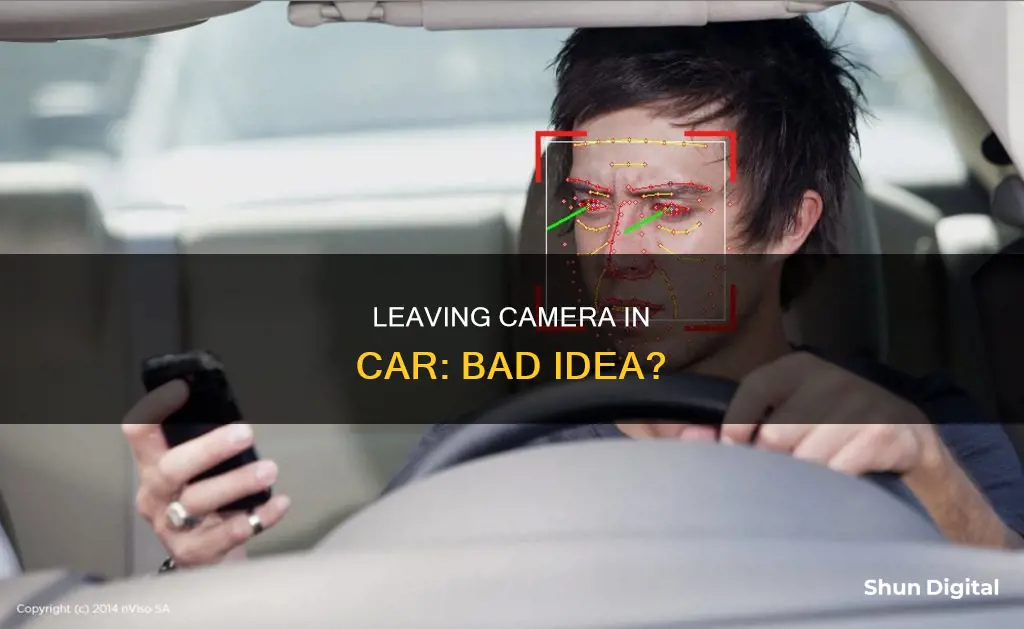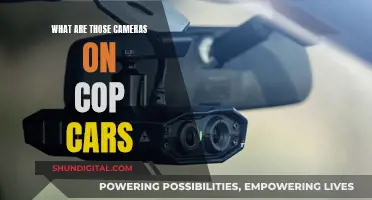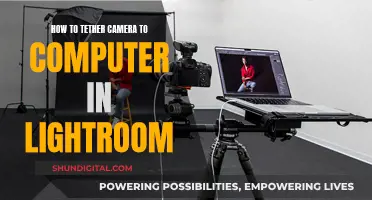
Leaving your camera in the car can be risky. Extreme temperatures can damage your camera's internal parts, and prolonged exposure to UV rays can cause the exterior finish to fade and certain materials to become weak and brittle. Heat can also affect the lubricants for the aperture blades in your lens, causing them to stick together and malfunction. In addition, there is a risk of theft if your camera is visible or if your car is broken into. To minimise the risks, keep your camera out of direct sunlight, preferably in the trunk of your car, and consider using a cooler or insulated bag to protect it from extreme temperatures.
| Characteristics | Values |
|---|---|
| Extreme heat damage | Possible damage to camera parts, lens, and adhesives. |
| Extreme cold damage | Condensation can be an issue when moving camera to a warm, humid environment. |
| Theft | High risk. |
What You'll Learn

Heat damage to camera parts
Leaving your camera in the car can cause damage to its parts due to the high temperatures inside the vehicle. The cabin of most cars can get very hot during the summertime, with temperatures soaring to 160ºF/71ºC or even higher. While storage temperature ratings for cameras vary, most cameras are rated for temperatures between 0 and 40ºC or 32ºF to 104ºF. Prolonged exposure to temperatures beyond this range can affect some of the most delicate parts of your camera.
One of the main concerns with leaving a camera in a hot car is the potential damage to the camera's electronics. Extreme heat can cause issues with the camera's circuitry and sensors, leading to blurry or "foggy" images. In some cases, the camera may stop working altogether. Additionally, adhesives used in the camera's construction can soften in high temperatures, causing components to become loose or detach. This can result in a loss of focus or other optical issues.
Another issue to consider is the impact of heat on the camera's lens. Lenses are made up of multiple elements and calibrated with precision. Prolonged exposure to high temperatures can affect the calibration, causing blurry or distorted images. The heat can also cause the lens coatings to degrade, resulting in reduced image quality.
Furthermore, extreme temperatures can affect the camera's battery life, reducing its overall lifespan and performance. Intense heat can also cause the camera's body to warp or deform, affecting its structural integrity and potentially impacting its functionality.
To minimise the risk of heat damage, it is recommended to avoid leaving your camera in direct sunlight or in a car for extended periods. If you must leave your camera in the car, consider storing it in a well-insulated camera bag or case and placing it in the trunk, where temperatures are generally cooler. Additionally, allowing your camera to cool down before use and protecting it from condensation during temperature transitions can help mitigate potential issues.
Computer Cameras: Trustworthy or Deceitful?
You may want to see also

Cold weather and condensation
Condensation is a common issue when moving your camera from cold weather into a warm and humid environment. The problem is not the moisture you may see on the outside of the camera, but the moisture that condenses inside its internal parts. Electronics and moisture do not mix well, and condensation inside a camera can cause damage to the inner elements of lenses and other components.
To avoid condensation, you can seal your camera gear in an airtight plastic bag before bringing it inside. The camera will then be surrounded by the very dry air from outdoors, and any condensation will form on the outside of the bag. You can also put your camera inside a cool room and leave it there for several hours until it reaches room temperature.
Another option is to use a dry cabinet to store your camera gear. A dry cabinet will help to keep your equipment at a constant, dry temperature, preventing condensation from forming.
It is also important to avoid placing a cold camera under your coat, as humid air can become trapped and condensation can form on both the optics and electronics. Instead, keep your camera in a camera bag or protective case when moving between cold and warm environments.
By taking these precautions, you can help to prevent condensation and keep your camera in good condition during cold weather.
Mounting a Battery Plate: A Guide for Cameramen
You may want to see also

Camera theft
- Insurance: Consider getting insurance for your camera equipment. Most policies offer theft and loss coverage, as well as damage insurance and coverage for rented or borrowed gear. Compare rates and coverage from different companies, as they can vary significantly. Joining photography organizations may also provide access to additional insurance options. Alternatively, you can get coverage through a rider on your homeowner's or renter's insurance policy, but the cost and availability may vary.
- Ownership Registration: Register yourself as the owner when purchasing camera equipment. This can help in recovering stolen items, especially if they are from smaller companies with more personal relationships with their dealers and repair centers. Additionally, use online services like StolenProperty.com, StolenLostFound.org, or LensTag to register your gear by serial number and report it if it's stolen.
- Security Measures: Always secure your camera gear, whether stored at home or while out shooting. Never check your camera bag with your luggage when travelling; always carry it with you. Avoid leaving your gear unattended, even for a short period. Use proximity and motion alarms, such as Tool Guard, to protect your equipment when you can't keep a close eye on it.
- Theft-Deterrent Labels: Consider using theft-proof labels, such as those from STOP, which are almost impossible to remove and leave an indelible "Stolen Property" tattoo if someone tries to scrape them off. You can also use invisible ink markers to write your information, which can only be seen under UV light.
- RFID Tags: For expensive gear, consider using RFID tags, which can be implanted or glued discreetly inside camera equipment. These tags can be scanned to identify your gear if it's stolen and help in recovery efforts.
- Serial Number Tracking: Always keep a record of your camera's serial number. In the event of theft, the police can use this information to help locate and recover your camera. Additionally, serial numbers in EXIF data can be used to search for photos posted online, which may lead to the identification of the thief.
- Be Vigilant: Always be aware of your surroundings and trust your instincts. If something feels off, leave the area or refrain from taking out your camera. Avoid crowded areas where thieves can easily target you.
- Common Sense: Ultimately, use common sense to protect yourself and your equipment. Don't leave your camera unattended, and if you must leave it in your vehicle, keep it out of direct sunlight and hidden from view to reduce the risk of theft.
Surveillance Camera Wiring: A Guide to Running Cables
You may want to see also

Battery life
Extreme temperatures can affect the performance of your camera's battery. In cold weather, batteries produce electricity more slowly and less efficiently, and a battery can run down extremely quickly. A fully charged camera battery in cold conditions may only last half as long, or less, than it normally would on a warm day.
To protect your camera's battery life in cold weather, consider the following:
- Bring extra batteries.
- Keep your spare batteries in an inner pocket of your coat or jacket, or in a warm place.
- If your battery has died, remove it from the camera and let it warm up in your pocket.
- Use hand warmers to keep your batteries warm.
- Keep your batteries close to your body, such as in an inside coat pocket.
- Do not warm up your batteries too quickly. Avoid placing them too close to a heat source, such as a fire or heater, as this can damage the battery.
- Turn off the camera when you're not using it.
- Wrap the camera in a sweater or an extra layer of clothing when you're not using it.
Focus Screen Scratches: Do They Impact Autofocus?
You may want to see also

Sensor noise
Leaving your camera in the car is generally not recommended, as extreme temperatures can affect some of the most delicate parts of your camera. If left in direct sunlight, long-term exposure to UV rays can also fade the exterior finish and cause some materials to become weak and brittle.
Now, onto sensor noise.
Image noise is the random variation of brightness or colour information in images and is usually related to electronic noise. It can be produced by the image sensor and circuitry of a digital camera. Image noise is an undesirable by-product of image capture that obscures the desired information.
Types of Sensor Noise
There are several types of noise that can affect a camera sensor:
- Dark Shot Noise: This is caused by a current that flows even when no photons are incident on the camera. It is a thermal effect resulting from electrons spontaneously generated within the silicon chip. The noise is independent of the signal level but depends on the temperature of the sensor.
- Read Noise: This is the noise generated when producing the electronic signal. It results from the sensor and camera electronics design and is independent of the signal level and sensor temperature. Faster CCD pixel clock rates can increase read noise.
- Photon Shot Noise: This is the statistical noise associated with the arrival of photons at the pixel. It follows Poisson statistics and is dependent on the signal level but independent of sensor temperature.
- Fixed Pattern Noise: Caused by spatial non-uniformities of the pixels, this type of noise is independent of the signal level and sensor temperature.
Total Effective Noise
The total effective noise per pixel is the quadrature sum of each of the noise sources mentioned above. If photon shot noise is significantly larger than dark shot noise and read noise, then the total effective noise is approximately equal to the photon shot noise.
Effects of Sensor Size
The amount of light collected over the whole sensor during exposure largely determines the signal levels that, in turn, determine the signal-to-noise ratio for shot noise and apparent noise levels.
The f-number indicates light density in the focal plane (photons per square micron). With a constant f-number, a larger lens aperture diameter collects more light from the subject. As the focal length required to capture a scene at a specific angle of view is roughly proportional to the width of the sensor, the amount of light collected is roughly proportional to the area of the sensor, resulting in a better signal-to-noise ratio for larger sensors.
However, with constant aperture diameters, the amount of light collected is independent of sensor size, and signal-to-noise ratio for shot noise is also independent of sensor size. In bright light conditions, where images are in the shot noise-limited regime, noise depends primarily on the total light over the whole sensor area, not the pixel count.
For images at lower signal levels (higher ISO settings), where read noise is significant, more pixels within a given sensor area will result in a noisier image if the per-pixel read noise is the same.
High and Low ISO Noise
The ISO setting on a digital camera is the first user-adjustable gain setting in the signal processing chain. It determines the amount of gain applied to the voltage output from the image sensor and affects read noise.
In bright, sunny conditions, there may be sufficient photons hitting the image sensor to completely fill the pixel wells, resulting in optimal exposure and a high signal-to-noise ratio or low noise.
Conversely, in darker conditions, there may be a lack of sufficient photons, resulting in a low signal-to-noise ratio or high noise, predominantly read noise. Increasing the ISO setting will amplify the low voltage from the image sensor, improving the signal-to-noise ratio through the remaining signal processing electronics.
Therefore, a higher ISO setting does not necessarily generate a higher noise level and can, in fact, reduce read noise. Any increase in noise at higher ISO settings is typically due to the amplification of shot noise and a lower dynamic range due to technical limitations.
Water-damaged Cameras: How Did This Happen?
You may want to see also
Frequently asked questions
Yes, it is bad to leave your camera in the car in hot weather. The internal temperature of a car can get extremely hot, exceeding 120°F/50°C in some cases. This can damage the camera's internal components, especially the lubricants for the aperture blades, and cause condensation issues.
There are a few things you can do to reduce the risks of leaving your camera in the car in hot weather:
- Park in the shade or cover your car with a light-coloured sheet or blanket to create your own shade.
- Keep your camera out of direct sunlight by placing it in the trunk/boot, under a seat, or in a cooler with ice packs.
- Cover your camera with a light-coloured cloth when not in use.
- Crack the windows to allow for some airflow.
Cold weather is generally less of a concern than hot weather, but condensation can be an issue when moving your camera from a cold environment to a warm, humid one. It is recommended to keep your camera in a bag or protective case to avoid condensation on the outside of the camera.
Yes, theft is a major concern when leaving your camera in the car. It is recommended to keep your camera out of sight, locked in the trunk/boot, or secured with a locking theft-resistant bag.







